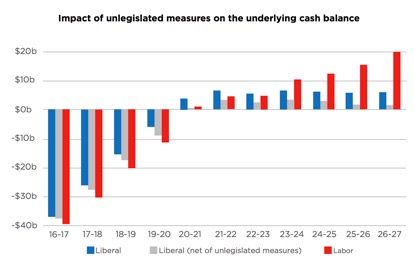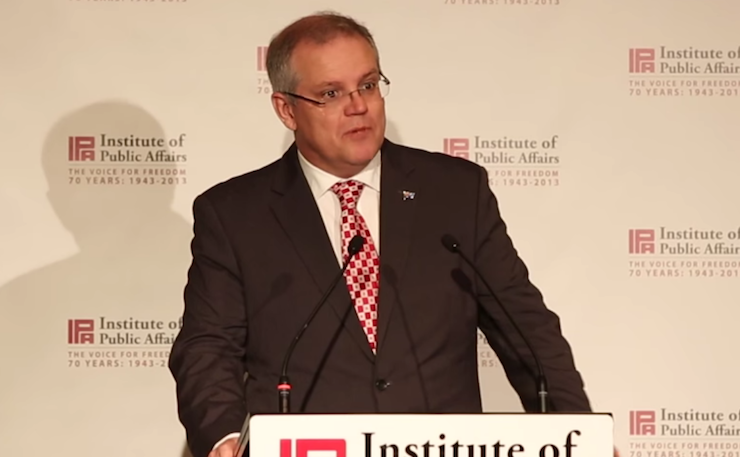The obsession both sides of politics have with getting the budget back to surplus is punishing the poor, entrenching high unemployment, and undermining our democracy, writes Owen Bennett.
Yesterday Treasurer Scott Morrison released the Coalition’s final election costings, announcing a fresh $2.3 billion cut in social security funding over the next four years.
Under the proposal – the third crackdown on social security payments in the past 12 months – the Coalition will introduce tougher measures to prosecute social security recipients trying to “thwart” the system, as well ramp up efforts to rein in outstanding Centrelink debts.
While the details of the policy are yet to be confirmed, the crackdown will subject social security recipients to more frequent and stricter reporting requirements, as well as increased auditing for undeclared income.
“The measures we announced today go to assisting people that are in receipt of welfare payments to better be able to comply with the requirements of that system”, said Morrison.
By the time of writing, Morrison had not yet elaborated on how hounding social security recipients for money would “assist” them.
To justify the crackdown Morrison instead reiterated the Coalition’s familiar talking points: getting the budget back to surplus and, of course, Labor’s economic shortcomings.
“Today I have announced that there will be some $2.3 billion in additional savings”, Morrison said. “Now that means that there will be a $1.1 billion improvement to the budget that we announced… that compares to a $16.5 billion worsening of the budget under what Labor will propose.”
Labor finance spokesman Tony Burke responded stating that the Coalition’s changes would “see the budget deteriorate structurally”.
At no point did Burke or any other Labor representative criticise the Coalition’s crackdown on social security. Rather, it was the budget surplus that was the main focus.
“Our [plan] is improving the budget by $8 billion; theirs is an attack on the budget by $13 billion”, said Burke.
Don’t be fooled by the carefully choreographed economic ‘blame-game’ going on between Labor and the Coalition – when it comes to the federal budget, both parties share the same fundamental economic position.
In its ‘10 Year Economic Plan’ released earlier this month, Labor announced that it would match the Coalition’s pledge to bring the federal budget back into a surplus of 1 per cent of GDP by 2020/2021.
Under the Labor Party’s plan, it would spend $16.5 billion more than the Coalition over the next four years before cutting the budget significantly to deliver a small surplus by 2020/21.
In its election costings released on Sunday, the Labor Party added that in 10 years time it would have a $15.5 billion surplus compared to the Coalition’s $6 billion.

Despite Labor and the Coalition sharing identical timelines to bring the budget back to surplus, both sides continue to attack each other over economic issues.
“Mr Shorten is prosecuting an anti-business, anti-growth agenda, more toxic and backward-looking than any Labor leader in a generation”, said Turnbull at the Coalition’s recent campaign launch.
Not to be outdone, Bill Shorten declared that if elected Labor would “achieve balance in the same year that the Liberal Party is saying, and over the 10-year period we will, in our opinion, based on the economic forecasts and the information provided to us, we will have a much stronger financial position.”
“The contrast between Labor and the Liberals could not be more stark”, concluded a straight-faced Shorten.
As this facile ‘my surplus is better than your surplus’ squabble droned on, both major parties have continued with the real work of justifying their shared commitment to wipe out the federal budget deficit ($37.1 billion) and, ultimately, the net government debt ($202 billion).
Here, both parties have formed a formidable public relations team promoting the neo-liberal economic doctrine of surplus budgets and small government.
“We will not be a big-spending government”, assured Shorten at recent campaign speech. “We will be a government for the fair go, fully paid for, bringing down the deficit every year.”
Following in the footsteps of the Coalition’s May budget, Labor is proposing extensive budget cuts over the next decade to achieve a surplus.
In its ‘10-Year Economic Plan’, Labor committed to cutting at least $105.4 billion of government expenditure over the next decade.
Central to the Labor Party’s message is that, unlike the Coalition, it can get the budget back to surplus while maintaining a commitment to ‘fairness’ – “budget repair that’s fair” is what they’re calling it.
HOUSE AD – NEW MATILDA NEEDS YOUR HELP. OUR LATEST FUNDRAISER ON POZIBLE IS HERE. HELP US PAY OUR HUGE LEGAL BILLS AND KEEP INDEPENDENT MEDIA ALIVE!
However, a quick look through the Labor Party’s proposed budget cuts reveals that its ‘savings measures’ would leave hundreds of thousands of low-income earners significantly worse off.
These cuts include:
- Scrapping the School Kids Bonus, saving $4.5 billion over 10 years. Eligible parents will lose up to $856 a year for each of their school-age children.
- Imposing an $8,000 yearly cap on VET FEE-HELP loans for students, saving $7.9 billion. This is in addition to a further $188 million cut in other student loan arrangements and a $3.7 billion cut to university research funding.
- Halving the Family Tax Benefit (Part A), saving $2.1 billion. This cut will cost 137,000 low to middle-income families $360 per child per year.
- Freezing the means test threshold for certain family benefits, saving $800 million.
- Scrapping the Government’s proposal for a $1,000 baby bonus to families with a child under one, saving $1.2 billion.
- Continuing the Coalition’s 2014 freeze of the indexation rate of the Medicare surcharge levy, saving $2.3 billion.
- Not opposing the Coalition’s cutting $3.6 billion in the aged pension and the Clean Energy Supplement for all new social security applicants. The Labor Party has also ignored calls to increase Newstart, which is $380 below the poverty line per fortnight.
With 3 million working-age Australians currently out of work, inequality rising to record levels, and sluggish economic growth, these cuts represent a cruel and misguided attack on the most vulnerable people in our society.
Achieving a budget surplus has replaced ‘fairness’ as the priority of the Labor Party.
With both parties committed to cutting at least $37 billion dollars from the budget over the next four years, Australian voters have been given no meaningful way to oppose austerity at the forthcoming election.
Whoever wins, the budget will be slashed and, as always, it will be the poor who suffer the most.
There is nothing new about Canberra’s obsession with surplus budgets. Since the mid 1970s, both sides of politics have advocated reducing government spending in order to balance the budget.
For decades we have been told that, like a household, the Government must live within its means. According to the neoliberals in Canberra, budget deficits burden future generations with a crippling national debt, shrink our economy and force Australians out of jobs.
We have all heard these sorts of claims before. But can they be backed up?
For Bill Mitchell, an internationally renowned Australian Professor of economics, the answer is no.
According to Mitchell, Canberra’s obsession with surplus is a “nonsensical narrative in terms of our historical experience”.
“85 per cent of the time the Federal Government in our recorded history has run fiscal deficits”, said Mitchell at a recent conference on Australia’s employment crisis.

As the non-government sector – made up of businesses and households – generally prefer to save some of their incomes, Mitchell argues that at any given time there is a portion of income that is not being recycled back as spending in the economy. If the government deficit does not fill the gap, then this leads to a fall in demand for goods and services which in turn results in their over-supply. Recession is the result.
“Firms will not hire people and produce goods and service unless people are spending”, said Mitchell.
“And if the non-government sector wants to save a bit of their income each week…unsold inventory will start to rise and [businesses]are going to start laying of workers, and that’s the start of a recession.”
To solve this problem and ensure high demand, throughout the post-war period successive governments – both Labor and Liberal – relied on deficit budgets.
“When non-government spending was weak the government would spend more, and when we were spending more they would spend less”, says Mitchell. “But they always had to run a deficit budget typically because we always wanted to save a bit.”
The yardstick used by governments to measure adequate demand in the economy was the unemployment rate – if unemployment rose, the government would increase spending to create jobs, thus stimulating demand.
“This is the period that I call the full employment period”, explains Mitchell. “This was where the federal government took responsibility under its international agreements to maintain enough spending in the economy to ensure that there was enough jobs for everybody.”
And it worked – between 1945 and 1973 unemployment averaged only 2 per cent in Australia.

As a result of Australia’s commitment to full employment, federal government debt as a percentage of GDP was substantial throughout the post-war period. By any measure, Australia’s current federal debt is at an historic low.
 Contrary to what is being said in Canberra, Australia’s high level of debt during this period did not lead to an economic slump. The reverse is true – it paved the way for one of the most prosperous periods of economic growth in Australian history, known as ‘the golden age’. Between 1960 and 1974 the Australian economy grew at 4.5 per cent per year, compared to 3.1 per cent from 1974 onwards.
Contrary to what is being said in Canberra, Australia’s high level of debt during this period did not lead to an economic slump. The reverse is true – it paved the way for one of the most prosperous periods of economic growth in Australian history, known as ‘the golden age’. Between 1960 and 1974 the Australian economy grew at 4.5 per cent per year, compared to 3.1 per cent from 1974 onwards.
Given the success of decades of government deficits, why are both sides of politics now obsessed with getting the country back into surplus?
Put simply, it is what big business wants.
Big business was always uncomfortable with the federal government’s commitment to full employment. With so many jobs in the economy during the full employment period, workers could confidently demand better wages and conditions without risking years in the dole queue.
As a result, real wage growth – as well trade union membership – was the highest on record during the full employment period. From the perspective of business, this had to change.

Demonising deficit budgets was therefore an obvious – and highly effective – first move by big business and their supporters. Once both sides of politics abandoned full employment and began attempting to balance the budget from the mid 1970s onward, suddenly unemployment skyrocketed leading to real wage growth and trade union membership falling – a veritable paradise for business.
Consequently, from the mid 1970s onward, capital’s share of income steadily increased while workers’ share sharply decreased.
As the government withdrew from the economy, Australian citizens were left with the bill for funding government services. In a 2011 study, David Richardson noted that if the then Gillard Government delivered a surplus of 1 per cent of GDP as promised, it would cost the average tax payer at least $1,300 per year to fund government services.
Unsurprisingly, Canberra’s surplus obsession has led to skyrocketing levels of non-government debt. With the government cutting its expenditure, it was up to everyone else to fill the gap. A recent leak by the Australian banking regulator warned that Australia’s level of private debt – the highest in the world – risks leading us straight into a recession.
Canberra has not just ignored these warnings: it has carried out a systematic campaign of misinformation justifying its surplus obsession. The corporate media, for its part, has enabled Canberra’s surplus obsession by accepting without question the claims of politicians that surplus budgets are inherently good for everyone. The reality, however, is that consistent surplus budgets entrench unemployment, put the breaks on real wage grown and ultimately, the economy.
Next time a politician or a political commentator starts talking about the necessity of surplus budgets, ask yourself: whose interests will that serve?
HOUSE AD – NEW MATILDA NEEDS YOUR HELP. OUR LATEST FUNDRAISER ON POZIBLE IS HERE. HELP US PAY OUR HUGE LEGAL BILLS AND KEEP INDEPENDENT MEDIA ALIVE!
Donate To New Matilda
New Matilda is a small, independent media outlet. We survive through reader contributions, and never losing a lawsuit. If you got something from this article, giving something back helps us to continue speaking truth to power. Every little bit counts.





